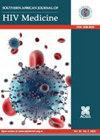巨细胞病毒性视网膜炎与抗逆转录病毒治疗:15年经验
IF 2.3
4区 医学
Q4 INFECTIOUS DISEASES
引用次数: 0
摘要
南非的公共抗逆转录病毒治疗(ART)规划自2004年推出以来经历了渐进式的变化。在SA中,这对艾滋病定义的机会性感染巨细胞病毒视网膜炎(CMVR)负担的影响尚未得到充分的认识。目的确定南澳大利亚州公共部门抗逆转录病毒治疗可及性对新诊断CMVR病例数随时间变化趋势的影响。方法:回顾性研究于2002年11月1日至2017年8月31日在夸祖鲁-纳塔尔省一家三级医院进行。结果共纳入383名参与者,其中60.1%为女性,94%为非洲黑人。患者平均年龄34.08岁(SD±7.24)。线性趋势模型显示,每年CMVR新病例数总体呈线性下降(R2为0.67)。CD4+≤350 cells/μL的HIV感染者(PLWH)在ART治疗前和ART治疗后每年平均新增CMVR病例数分别为34例和13例,差异有统计学意义(61.76%),P = 0.001。诊断CMVR时CD4+计数中位数为22(四分位数范围:9 ~ 51.25)个细胞/μL。在这项研究中,51%的患者在诊断CMVR时接受了ART治疗。ART≤6个月的患者比例(63.3%)高于ART≤6个月的患者比例(36.7%),差异有统计学意义,P < 0.01。结论抗逆转录病毒治疗减轻了KZN地区许多CMVR患者的眼科服务负担,特别是在所有CD4≤350细胞/μL的PLWH引入抗逆转录病毒治疗后。本文章由计算机程序翻译,如有差异,请以英文原文为准。
Cytomegalovirus retinitis and antiretroviral treatment: A fifteen year experience
Background South Africa’s public antiretroviral treatment (ART) programme has undergone progressive changes since its introduction in 2004. The effect of this on the burden of the AIDS-defining opportunistic infection, cytomegalovirus retinitis (CMVR), in SA, has not been fully appreciated. Objectives To determine the effect of ART availability in the public sector of SA on the trend in the number of cases of newly diagnosed CMVR over time. Methods This is a retrospective study from 01 November 2002 to 31 August 2017 that took place at a tertiary hospital in the KwaZulu-Natal (KZN) province. Results A total of 383 participants were included in the study, with 60.1% being female and 94% of black African origin. The mean age of patients was 34.08 years (SD ± 7.24). A linear trend model suggested an overall linear decrease in the number of new cases of CMVR per year (R2 of 0.67). The average number of new cases of CMVR per year prior to ART being available to all persons living with HIV (PLWH) with a CD4+ ≤ 350 cells/μL and after was 34 and 13, respectively, and the difference (61.76%) between these values was statistically significant, P = 0.001. The median CD4+ count at diagnosis of CMVR was 22 (interquartile range: 9–51.25) cells/μL. An overall 51% of patients in this study were on ART at diagnosis of CMVR. There was a higher proportion of patients on ART ≤ 6 months (63.3%), compared with those on ART > 6 months (36.7%), and the difference was statistically significant, P < 0.01. Conclusion ART has resulted in a decrease in the burden of CMVR on ophthalmic services for many in KZN, particularly following the introduction of ART for all PLWH with a CD4 ≤ 350 cells/μL.
求助全文
通过发布文献求助,成功后即可免费获取论文全文。
去求助
来源期刊
CiteScore
2.80
自引率
11.80%
发文量
41
审稿时长
>12 weeks
期刊介绍:
The Southern African Journal of HIV Medicine is focused on HIV/AIDS treatment, prevention and related topics relevant to clinical and public health practice. The purpose of the journal is to disseminate original research results and to support high-level learning related to HIV Medicine. It publishes original research articles, editorials, case reports/case series, reviews of state-of-the-art clinical practice, and correspondence.

 求助内容:
求助内容: 应助结果提醒方式:
应助结果提醒方式:


